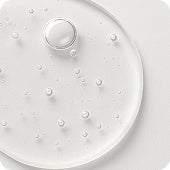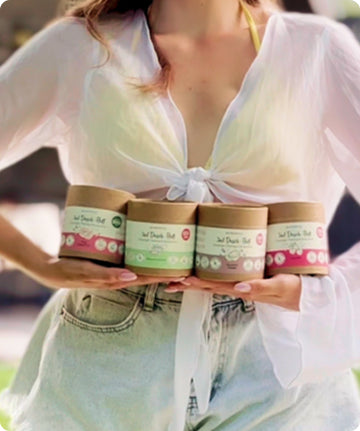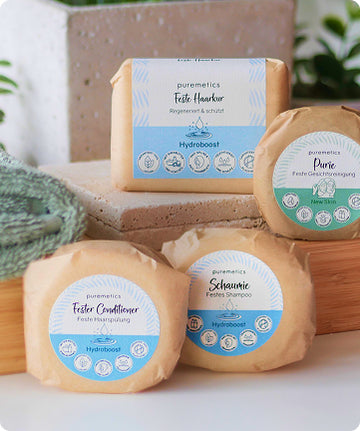The difference between fatty and essential oils in cosmetics
The difference between fatty and essential oils in cosmetics

Production, application, effect and examples
Oils play a crucial role in the world of cosmetics, but not all oils are created equal. Two main categories that are often used are fatty oils and essential oils. These differ not only in their production, but also in their application, effect and chemical composition.
The most important differences summarized
Fatty oils
- Obtained by cold pressing or extraction from seeds, nuts or fruits.
- Triglyceride based, rich in fatty acids, vitamins and antioxidants.
- Ideal as moisturizers and as base oils in blends with essential oils.
- Moisturizing, strengthening the skin barrier, antioxidant.
Essential oils
- Obtained by distillation or extraction from plant materials.
- Contain volatile compounds such as terpenes, phenols, aldehydes in highly concentrated form.
- Often diluted in skin care products, massage or aromatherapy.
- Diverse effects depending on the type, e.g. B. anti-inflammatory, antimicrobial, calming.

Why is it important to know the differences?
Understanding the differences between fatty and essential oils in cosmetics is crucial because these two types of oils have different properties and uses. Here are some reasons why it's important to know these differences:
Purposeful use: Fatty oils are particularly suitable for skin care as they are moisturizing and can provide the skin with important nutrients. Essential oils, on the other hand, are often used for therapeutic or fragrant purposes due to their concentrated nature. A clear understanding enables targeted selection according to the desired results.
Avoiding Skin Irritation: Essential oils are highly concentrated and if not diluted properly can cause skin irritation. Knowing how to dilute and use it safely is therefore crucial to prevent unwanted skin reactions.
Chemical composition and effect: The different chemical composition leads to different effects on the skin. While fatty oils primarily moisturize and strengthen the skin barrier, essential oils offer a wide range of therapeutic effects, such as antimicrobial or anti-inflammatory properties.
Versatile application possibilities: Knowledge of the versatility of application makes it possible to integrate the oils into various cosmetic products. Fatty oils can be used in moisturizers, lotions, and serums, while essential oils can be used in fragrances, massage oils, or specialty skin care products.
Optimal care routine: By knowing the differences, you can create a tailor-made care routine that meets the individual needs of your skin. This enables effective care and helps improve skin health.
In summary , knowing the differences between fatty and essential oils in cosmetics is beneficial for making the right skin care decisions, avoiding skin irritation, and achieving desired cosmetic goals.

Manufacturing
Fatty oils are obtained from plants by cold pressing or extraction. This process involves squeezing or extracting the oils from seeds, nuts or fruits. This gentle method preserves the nutrients and natural scent.
- Examples: olive oil, almond oil, jojoba oil
In contrast , essential oils are obtained through distillation or extraction from the leaves, flowers, stems or roots of plants. Distillation involves passing steam through the plant materials and extracting the essential oils through condensation.
- Examples: lavender oil, tea tree oil, peppermint oil

Chemical composition
Fatty oils are triglyceride-based and contain various fatty acids that are important for skin care. They are rich in nutrients such as vitamins and antioxidants that moisturize the skin and protect it from free radicals.
- Example: Olive oil contains omega-3 fatty acids that nourish and soothe the skin.
Essential oils consist of volatile compounds and are highly concentrated. These compounds can be terpenes, phenols, aldehydes and others. Their effect on the skin is often strong, and they are often diluted to avoid skin irritation.
- Example: Tea tree oil has antimicrobial properties that can help treat acne.

Application
Fatty oils make excellent moisturizers and can be applied to the skin to leave it soft and supple. They can also serve as a base oil in blends with essential oils.
- Example: Almond oil is suitable as a massage oil and moisturizes the skin.
Essential oils are often used in diluted form and can be used in skin care products, massage or aromatherapy. They are valued for their therapeutic properties.
- Example: Lavender oil can have a calming effect and is often used in skin care products for sensitive skin.

Effect
Fatty oils have a moisturizing effect and help strengthen the skin barrier. They may also have antioxidant properties that slow the aging process of the skin.
- Example : Jojoba oil regulates the skin's moisture balance and balances oily or dry skin.
Essential oils vary in their effects depending on the type of oil. Some have anti-inflammatory, antimicrobial, or calming properties.
- Example: Tea tree oil is known for its antibacterial properties and is often used to treat skin blemishes.

Need in cosmetics
Both fatty and essential oils can play an important role in cosmetics. The correct application depends on the individual needs of the skin and the desired results. It is important to understand the different properties and effects of the oils in order to incorporate them effectively and safely into your daily care routine.
Conclusion: The key to understanding the diversity in the world of cosmetic oils
The distinction between fatty and essential oils in cosmetics plays a crucial role in effective skin care. The manufacturing processes, chemical composition, uses and effects of these two types of oil are diverse and offer a wide range of options for individual skin needs.
Knowledge of the origin and composition of the oils enables a targeted selection according to the desired effects. Fatty oils, rich in nutrients, are particularly suitable for moisturizing and strengthening the skin barrier. Essential oils, due to their highly concentrated nature, find application in therapeutic or aromatic products.
Correct use of both types of oil is crucial to avoid skin irritation and reap their full benefits. These differences not only open up the possibility of a tailored skin care routine, but also offer versatile applications in a variety of cosmetic products.
In the world of cosmetic oils, knowledge is power. Consciously choosing the right oils based on individual needs leads to effective care and supports the pursuit of healthy and radiant skin. Therefore, it is essential to understand the differences between fatty and essential oils in order to realize the full potential of these natural treasures.










